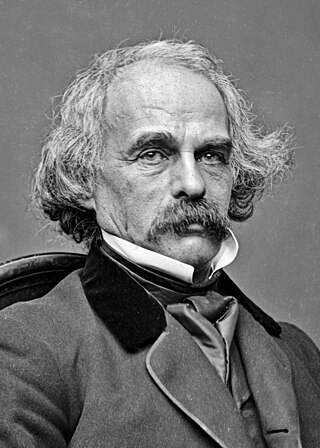
Nathaniel Hawthorne was an American novelist and short story writer. His works often focus on history, morality, and religion.

The Scarlet Letter: A Romance is a work of historical fiction by American author Nathaniel Hawthorne, published in 1850. Set in the Puritan Massachusetts Bay Colony during the years 1642 to 1649, the novel tells the story of Hester Prynne, who conceives a daughter with a man to whom she is not married and then struggles to create a new life of repentance and dignity. As punishment, she must wear a scarlet letter 'A'. Containing a number of religious and historic allusions, the book explores themes of legalism, sin and guilt.

"Young Goodman Brown" is a short story published in 1835 by American writer Nathaniel Hawthorne. The story takes place in 17th-century Puritan New England, a common setting for Hawthorne's works, and addresses the Calvinist/Puritan belief that all of humanity exists in a state of depravity, but that God has destined some to unconditional election through unmerited grace. Hawthorne frequently focuses on the tensions within Puritan culture, yet steeps his stories in the Puritan sense of sin. In a symbolic fashion, the story follows Young Goodman Brown's journey into self-scrutiny, which results in his loss of virtue and belief.

The Marble Faun: Or, The Romance of Monte Beni, also known by the British title Transformation, was the last of the four major romances by Nathaniel Hawthorne, and was published in 1860. The Marble Faun, written on the eve of the American Civil War, is set in a fantastical Italy. The romance mixes elements of a fable, pastoral, gothic novel, and travel guide.
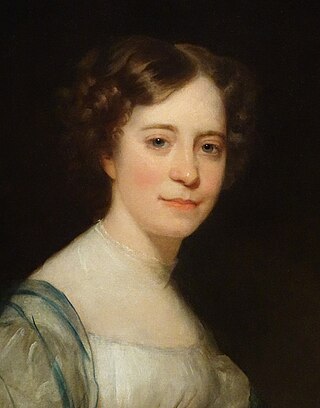
Sophia Amelia Hawthorne was an American painter and illustrator as well as the wife of author Nathaniel Hawthorne. She also published her journals and various articles.

The House of the Seven Gables is a 1668 colonial mansion in Salem, Massachusetts, named for its gables. It was made famous by Nathaniel Hawthorne's 1851 novel The House of the Seven Gables. The house is now a non-profit museum, with an admission fee charged for tours, as well as an active settlement house with programs for the local immigrant community including ESL and citizenship classes. It was built for Captain John Turner and stayed with the family for three generations.

James Thomas Fields was an American publisher, editor, and poet. His business, Ticknor and Fields, was a notable publishing house in 19th century Boston.
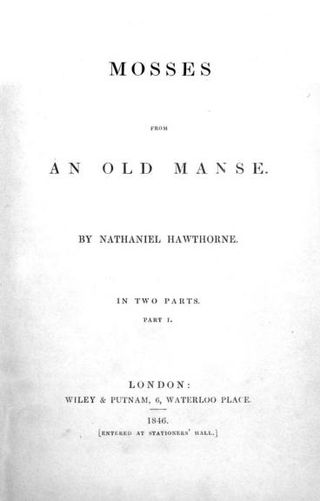
Mosses from an Old Manse is a short story collection by Nathaniel Hawthorne, first published in 1846.
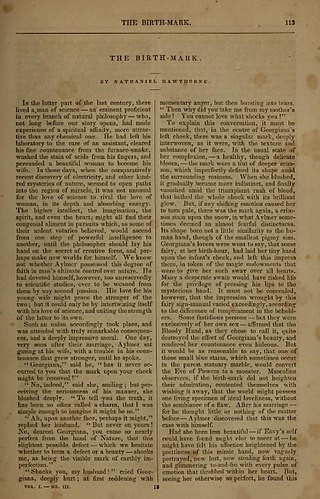
"The Birth-Mark" is a short story by American author Nathaniel Hawthorne. The tale examines obsession with human perfection. It was first published in the March 1843 edition of The Pioneer and later appeared in Mosses from an Old Manse, a collection of Hawthorne's short stories published in 1846.

Twice-Told Tales is a short story collection in two volumes by Nathaniel Hawthorne. The first volume was published in the spring of 1837 and the second in 1842. The stories had all been previously published in magazines and annuals, hence the name.

Julian Hawthorne was an American writer and journalist, the son of novelist Nathaniel Hawthorne and Sophia Peabody. He wrote numerous poems, novels, short stories, mysteries and detective fiction, essays, travel books, biographies, and histories.
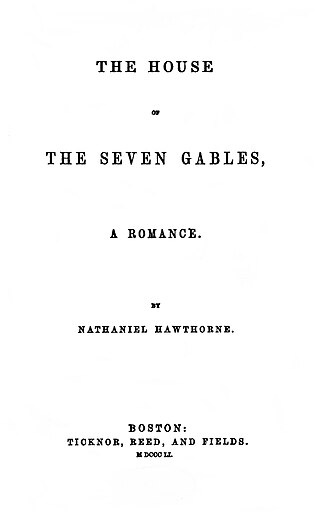
The House of the Seven Gables: A Romance is a Gothic novel written beginning in mid-1850 by American author Nathaniel Hawthorne and published in April 1851 by Ticknor and Fields of Boston. The novel follows a New England family and their ancestral home. In the book, Hawthorne explores themes of guilt, retribution, and atonement, and colors the tale with suggestions of the supernatural and witchcraft. The setting for the book was inspired by the Turner-Ingersoll Mansion, a gabled house in Salem, Massachusetts, belonging to Hawthorne's cousin Susanna Ingersoll, as well as ancestors of Hawthorne who had played a part in the Salem Witch Trials of 1692. The book was well received upon publication and has been adapted several times to film and television.

A Wonder-Book for Girls and Boys (1851) is a children's book by American author Nathaniel Hawthorne in which he retells several Greek myths. It was followed by a sequel, Tanglewood Tales.

"Feathertop" is a short story by Nathaniel Hawthorne, first published in 1852. The moral tale uses a metaphoric scarecrow named Feathertop and its adventure to offer the reader a conclusive lesson about human character. It has since been used and adapted in several other media forms, such as opera and theatre.

"Ethan Brand—A Chapter from an Abortive Romance" is a short story written by Nathaniel Hawthorne in 1850 and first published by Ticknor, Reed, and Fields in 1852 in The Snow-Image, and Other Twice-Told Tales, the author's final collection of short stories. Hawthorne originally planned a lengthy work about Brand, but completed only this piece. Hawthorne's inspiration was a lime kiln he saw burning while climbing Mount Greylock.
"The Man of Adamant" is a short story written by Nathaniel Hawthorne. It was first published in the 1837 edition of The Token and Atlantic Souvenir, edited by Samuel Griswold Goodrich. It later appeared in Hawthorne's final collection of short stories The Snow-Image, and Other Twice-Told Tales, published in 1852 by Ticknor, Reed & Fields.

"Egotism; or, The Bosom-Serpent" is a short story by Nathaniel Hawthorne published in 1843 in The United States Magazine and Democratic Review in New York.

"Chiefly About War Matters", originally credited "by a Peaceable Man", is an 1862 essay by American author Nathaniel Hawthorne. The essay was inspired by the author's traveling during the American Civil War to experience more of the conflict firsthand. Upon its publication, it was controversial for its somewhat pro-southern stance and antiwar sentiments. Hawthorne was also chastised for his unflattering descriptions of American president Abraham Lincoln.

"Hawthorne and His Mosses" (1850) is an essay and critical review by Herman Melville of the short story collection Mosses from an Old Manse written by Nathaniel Hawthorne in 1846. Published pseudonymously by "a Virginian spending July in Vermont", it appeared in The Literary World magazine in two issues: August 17 and August 24, 1850. It has been called the "most famous literary manifesto of the American nineteenth century."

"The Great Stone Face" is a short story published by Nathaniel Hawthorne in 1850. The story reappeared in a full-length book, The Snow-Image, and Other Twice-Told Tales, published by Ticknor, Reed & Fields in 1852. It has since been republished and anthologized many times.


















